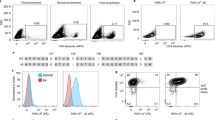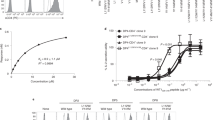Abstract
ANTIGENIC peptides are presented to CD8+T lymphocytes by class I major histocompatibility complex (MHC) molecules1,2. Peptides specifically bind to purified class I molecules in vitro3–7, and to class I molecules on cells at nonphysiological temperatures8. We report here the kinetic and equilibrium parameters for the binding of radiolabelled influenza nucleoprotein peptides (NP-Y365-380 and shorter homologues) to the murine H–2Db7 molecule on intact, viable cells at 37 °C. In contrast to earlier reports, we show that peptide binding is rapid and reversible, with dissociation constants ranging from nanomolar to micromolar, suggestive of typical ligand-receptor interactions. Only 10% of cell-surface Db7 molecules can bind these peptides. To address the relationship between peptide binding and T-cell recognition of the antigen-MHC complex, we determined the minimum number of complexes required to sensitize a target cell for lysis by class I-restricted cytotoxic T-lymphocytes. Our data indicate that EL4 thymoma cells (H-2b7) can be sensitized for lysis by cytotoxic T-lymphocytes when as few as 200 class I-peptide complexes (less than 0.08% of surface Db7 molecules) are present per cell.
This is a preview of subscription content, access via your institution
Access options
Subscribe to this journal
Receive 51 print issues and online access
$199.00 per year
only $3.90 per issue
Buy this article
- Purchase on Springer Link
- Instant access to full article PDF
Prices may be subject to local taxes which are calculated during checkout
Similar content being viewed by others
References
Townsend, A. R. M. et al. Cell 44, 959–968 (1986).
Townsend, A. & Bodmer, H. A. Rev. Immun. 7, 601–624 (1989).
Chen, B. P. & Parham, P. Nature 337, 743–745 (1989).
Choppin, J. et al. J. exp. Med. 172, 889–899 (1990).
Frelinger, J. A., Gotch, M. M., Zweerink, H., Wain, E. & McMichael, A. J. J. exp. Med. 172, 827–834 (1990).
Townsend, A. et al. Cell 62, 285–295 (1990).
Chen, B. P., Rothbard, J. & Parham, P. J. exp. Med. 172, 931–936.
Schumacher, T. N. M. et al. Cell 62, 563–567 (1990).
Rötzschke, O. et al. Nature 348, 252–254 (1990).
Lemke, H., Hämmerling, G. & Hämmerling, U. Immunol. Rev. 47, 175–206 (1976).
Carreno, B. M., Anderson, R. W., Coligan, J. E. & Biddison, W. E. Proc. natn. Acad. Sci. U.S.A. 87, 3420–3424 (1990).
Bodmer, H. C., Bastin, J. M., Askonas, B. A. & Townsend, A. R. M. Immunology 66, 163–169 (1989).
Buus, S., Sette, A., Colon, S. M., Jenis, D. M. & Grey, H. M. Cell 47, 1071–1077 (1986).
Ceppellini, R. et al. Nature 339, 392–394 (1989).
Rock, K. L., Rothstein, L. E., Gamble, S. R. & Benacerraf, B. Proc. natn. Acad. Sci. U.S.A. 87, 7517–7521 (1990).
Rock, K. L., Gamble, S., Rothstein, L. & Benacerraf, B. Proc. natn. Acad. Sci. U.S.A. 88, 301–304 (1991).
Vitiello, A., Potter, T. A. & Sherman, L. A. Science 250, 1423–1426 (1990).
Kozlowski, S. et al. Nature 349, 74–77 (1991).
Van Bleek, G. M. & Nathenson, S. G. Nature 348, 213–216 (1990).
Harding, C. V. & Unanue, E. R. Nature 346, 574–576 (1990).
Demotz, S., Grey, H. & Sette, A. Science 249, 1028–30 (1990).
Gorer, P. A. Br. J. Cancer 4, 372–380 (1950).
Hämmerling, G. J., Rüsch, E., Tada, N., Kimura, S. & Hämmerling, U. Proc. natn. Acad. Sci. U.S.A. 79, 4737–4741 (1982).
Hyman, R. & Stallings, V. Immunogenetics 3, 75–84 (1976).
Ozato, K., Mayer, N. & Sachs, D. H. J. Immun. 124, 533–540 (1980).
Smith, M. H., Parker, J. R. M., Hodges, R. S. & Barber, B. H. Molec. Immun. 23, 1077–1092 (1986).
Lagarde, A. E., Donaghue, T. P., Kerbel, R. & Siminovitch, L. Somatic Cell molec. Genet. 10, 503–519 (1984).
Ozato, K., Mayer, N. M. & Sachs, D. H. Transplantation 34, (1982).
Kilbourne, E. D. Bull. Wld Hlth Org. 41, 643–645 (1969).
Author information
Authors and Affiliations
Rights and permissions
About this article
Cite this article
Christinck, E., Luscher, M., Barber, B. et al. Peptide binding to class I MHC on living cells and quantitation of complexes required for CTL lysis. Nature 352, 67–70 (1991). https://doi.org/10.1038/352067a0
Received:
Accepted:
Issue Date:
DOI: https://doi.org/10.1038/352067a0
This article is cited by
-
Chlamydia spp. development is differentially altered by treatment with the LpxC inhibitor LPC-011
BMC Microbiology (2017)
-
Targeting of MYCN by means of DNA vaccination is effective against neuroblastoma in mice
Cancer Immunology, Immunotherapy (2015)
-
Differential expression of major histocompatibility complex class I in developmental glioneuronal lesions
Journal of Neuroinflammation (2013)
-
Graft versus neuroblastoma reaction is efficiently elicited by allogeneic bone marrow transplantation through cytolytic activity in the absence of GVHD
Cancer Immunology, Immunotherapy (2009)
-
Direct priming of antiviral CD8+ T cells in the peripheral interfollicular region of lymph nodes
Nature Immunology (2008)
Comments
By submitting a comment you agree to abide by our Terms and Community Guidelines. If you find something abusive or that does not comply with our terms or guidelines please flag it as inappropriate.



